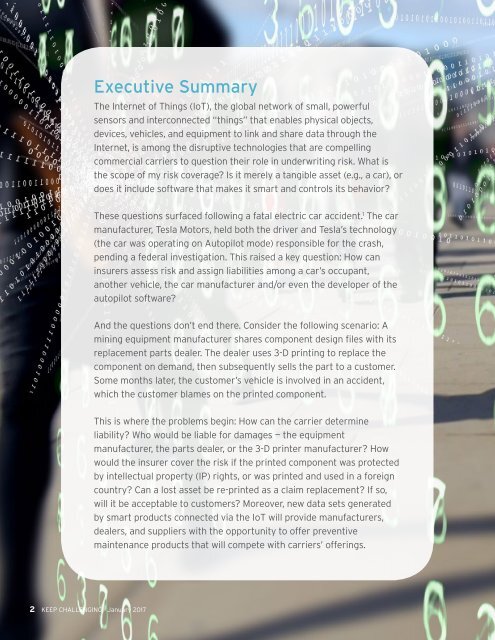Optimizing the Internet of Things Key Strategies for Commercial Insurers
optimizing-the-internet-of-things-key-strategies-for-commercial-insurers-codex2295
optimizing-the-internet-of-things-key-strategies-for-commercial-insurers-codex2295
You also want an ePaper? Increase the reach of your titles
YUMPU automatically turns print PDFs into web optimized ePapers that Google loves.
Executive Summary<br />
The <strong>Internet</strong> <strong>of</strong> <strong>Things</strong> (IoT), <strong>the</strong> global network <strong>of</strong> small, powerful<br />
sensors and interconnected “things” that enables physical objects,<br />
devices, vehicles, and equipment to link and share data through <strong>the</strong><br />
<strong>Internet</strong>, is among <strong>the</strong> disruptive technologies that are compelling<br />
commercial carriers to question <strong>the</strong>ir role in underwriting risk. What is<br />
<strong>the</strong> scope <strong>of</strong> my risk coverage? Is it merely a tangible asset (e.g., a car), or<br />
does it include s<strong>of</strong>tware that makes it smart and controls its behavior?<br />
These questions surfaced following a fatal electric car accident. 1 The car<br />
manufacturer, Tesla Motors, held both <strong>the</strong> driver and Tesla’s technology<br />
(<strong>the</strong> car was operating on Autopilot mode) responsible <strong>for</strong> <strong>the</strong> crash,<br />
pending a federal investigation. This raised a key question: How can<br />
insurers assess risk and assign liabilities among a car’s occupant,<br />
ano<strong>the</strong>r vehicle, <strong>the</strong> car manufacturer and/or even <strong>the</strong> developer <strong>of</strong> <strong>the</strong><br />
autopilot s<strong>of</strong>tware?<br />
And <strong>the</strong> questions don’t end <strong>the</strong>re. Consider <strong>the</strong> following scenario: A<br />
mining equipment manufacturer shares component design files with its<br />
replacement parts dealer. The dealer uses 3-D printing to replace <strong>the</strong><br />
component on demand, <strong>the</strong>n subsequently sells <strong>the</strong> part to a customer.<br />
Some months later, <strong>the</strong> customer’s vehicle is involved in an accident,<br />
which <strong>the</strong> customer blames on <strong>the</strong> printed component.<br />
This is where <strong>the</strong> problems begin: How can <strong>the</strong> carrier determine<br />
liability? Who would be liable <strong>for</strong> damages — <strong>the</strong> equipment<br />
manufacturer, <strong>the</strong> parts dealer, or <strong>the</strong> 3-D printer manufacturer? How<br />
would <strong>the</strong> insurer cover <strong>the</strong> risk if <strong>the</strong> printed component was protected<br />
by intellectual property (IP) rights, or was printed and used in a <strong>for</strong>eign<br />
country? Can a lost asset be re-printed as a claim replacement? If so,<br />
will it be acceptable to customers? Moreover, new data sets generated<br />
by smart products connected via <strong>the</strong> IoT will provide manufacturers,<br />
dealers, and suppliers with <strong>the</strong> opportunity to <strong>of</strong>fer preventive<br />
maintenance products that will compete with carriers’ <strong>of</strong>ferings.<br />
2 KEEP CHALLENGING December 2016<br />
2 KEEP CHALLENGING January 2017


